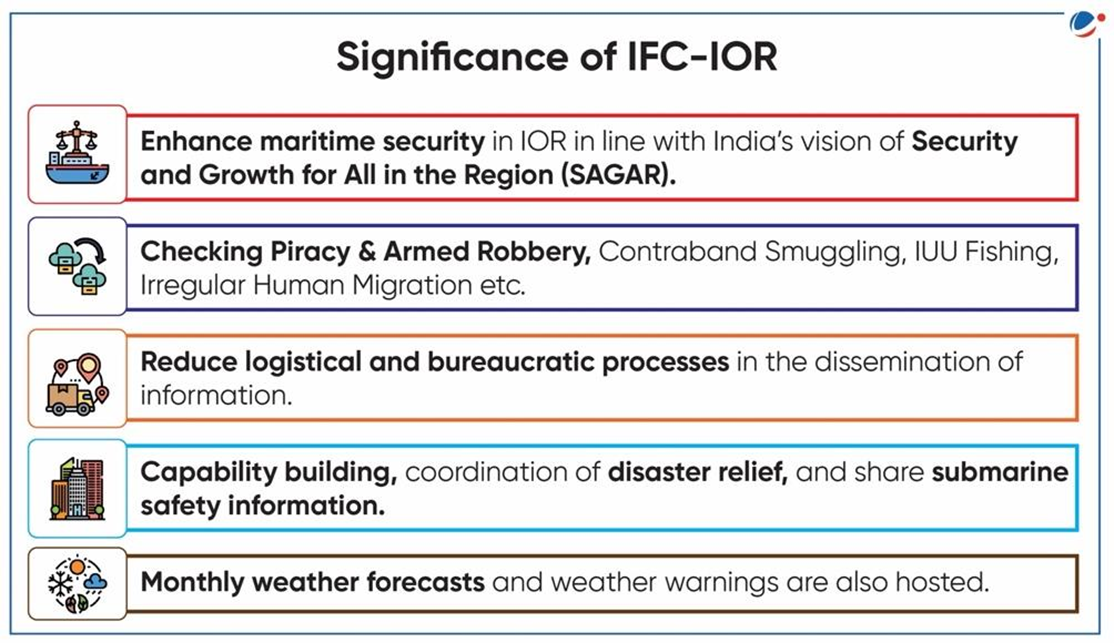Why in the News?
Recently, IFC-IOR played a crucial role in tackling the hijacking incident of the Malta-flagged vessel (Merchant Vessel) m.v. Ruen.
To know more about Maritimes Trade Routes, kindly refer to article "4.3. Securing Maritime Trade Routes" of December 2023 edition of the Monthly Current Affairs Magazine.
About IFC-IOR
- Genesis: IFC-IOR was established in 2018, based at IMAC, and hosted by the Indian Navy.
- Soon after 26/11, India brought together countries of the Indian Ocean rim to form the Information Management and Analysis Centre (IMAC) in 2014 in Gurugram.
- IMAC is jointly administered by the Indian Navy and Indian Coast Guard.
- Aim: Strengthening maritime security in the region by building a common coherent maritime situation picture using White Shipping Agreements.
- White Shipping Agreements deal with the sharing of information regarding commercial non-military merchant vessels.
- Region covered: Indian Ocean Region and adjoining Seas.
- 67 linkages in 25 countries have been established to secure the global commons for a peaceful, stable and prosperous region towards the well-being of all.
- Also, IFC-IOR hosts 12 International Liaison Officers (ILOs) from 12 partner nations viz. Australia, France, Italy, Japan, Maldives, Mauritius, Myanmar, Seychelles, Singapore, Sri Lanka, the UK and the USA.
- Four sectors: Gulf of Guinea, Gulf of Aden, Arabian Sea, and the Bay of Bengal & South East Asia.
- The Maritime Information Sharing Workshop (MISW): It is the flagship platform of IFC-IOR that conducts training programs and is attended by delegates from a large number of countries.

How does IFC-IOR strengthen India’s foreign relations?
- Strategic Partnership: A small group of India's strategic partners such as the USA, France, etc. have positioned their ILOs at the Gurgaon-based facility.
- Strengthening Neighbourhood relations: through the information-sharing framework. For example, Sri Lankan coastal surveillance radars being integrated into the IFC-IOR.
- Regional Cooperation: The IFC-IOR promotes regional cooperation by facilitating information exchange related to maritime security.
- India is developing 32 coastal surveillance radar stations in Sri Lanka, Mauritius, Seychelles and Maldives, all of which will feed data to the IFC-IOR.
Implementation challenges faced by IFC-IOR
- Challenges in information sharing such as issues with standardization, duplicative efforts, and differing organizational formats. This hinders the creation of a unified operational picture.
- Data Fusion and Analysis: Information sense-making poses a formidable challenge with member countries grappling with overcoming extra-regional influences and addressing domestic political motivations.
- Trust and coordination Issues: Multilateral collaborations often encounter challenges arising from restricted coordination scope or unwillingness to share data equitably.
Way forward
- Reciprocal Deployments: India should also deploy its ILOs in other nations’ centres.
- Enabling coordination and standardization: Efforts at the global level can be made to standardize information-sharing patterns and create collaborative arrangements to reduce duplication of effort.
- Continued Expansion: It should expand its information-sharing with more countries in and beyond the Indian Ocean Region, to give the initiative a more global character.
- Enhanced Maritime Surveillance: Augment MDA to cover grey shipping (military) and dark shipping (identity-hidden vessels) at the surface level.





